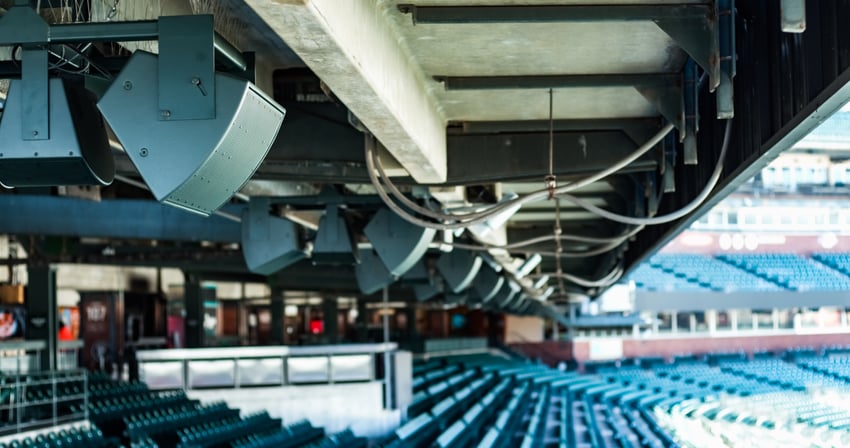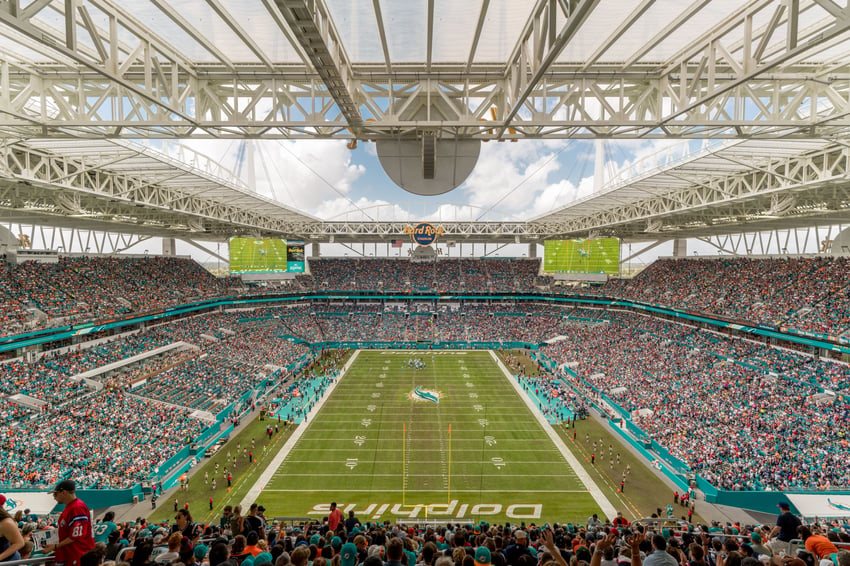Insights
How Stadium Technology is Redefining the Fan Experience
May 13, 2025
Audio Visual, Media Production
Game Changer: Why Stadium Technology is the MVP of the Modern Fan Experience
Walk into any modern sports venue today—be it a roaring NFL stadium, an MLB ballpark or a high-energy college arena—and you’ll notice something’s changed. Sure, the hot dogs are still overpriced, and the fans are still screaming.
But behind the giant LED screens, under the sleek scoreboards, and inside the control rooms… a quiet revolution is underway: SMPTE 2110.
But that’s just the beginning. From converged networks to immersive sound systems, the modern stadium tech stack is evolving fast—and with it, the entire game-day experience is getting a high-octane upgrade to dramatically enhance how we bring fans closer to the action.

The 2110 Advantage: IP at the Core of Smart Stadium Evolution
For years, stadiums and arenas relied on SDI (Serial Digital Interface)—a reliable but rigid baseband video standard. It worked. It got the job done. But like dial-up and flip phones in the era of smartphones, its limitations became more apparent as venue demands evolved.
Then came SMPTE 2110, shifting stadium technology from hardwired limitations to scalable, IP-based infrastructure. Suddenly, media production wasn’t tied to bulky routers and miles of cable. Instead, it was all about flexibility, scalability, and speed.
What does 2110 bring to the table?
- Separation of Streams: Audio, video, and ancillary data flow independently, allowing for customized routing and real-time manipulation.
- Bandwidth Optimization: Supports uncompressed HD, 4K, and HDR content without the latency drag.
- Easier Expandability: Want more replay servers or camera feeds? Just plug in a new node and go.
From an infrastructure standpoint, it's transformational. The shift from traditional SDI to SMPTE ST 2110 is redefining stadium technology, live events production, scalability, and the fan experience.

How 2110 Impacts the Fan Experience
Most stadium goers–whether they’re baseball, hockey, soccer or football fans–won’t know they’re watching a show powered by 2110. But they’ll absolutely feel it.
- More cameras and angles: Capture and share those “Did you see that?!” moments instantly. With less cable and more flexibility, production teams can deploy additional high-speed, wireless, or robotic cameras throughout the venue.
- Richer replays: Think ultra-slow motion, super-zoom, and even 360-degree recap moments shown within seconds of a play.
- Real-time graphics overlays: Cleaner, crisper data visuals on scoreboards and broadcast feeds, with zero lag.
- Remote production possibilities: Schools and teams can centralize control rooms and produce games from across campuses or cities, enabling broader coverage of simultaneous live events, including Olympic sports and non-revenue events.
The resulting fan experience feels smoother, sharper, and far more immersive—whether you're sitting in Section 101 or streaming on your phone from a thousand miles away.

3 Key Factors Behind the Rise of 2110
The adoption of 2110 isn’t happening in a vacuum. It’s the result of three converging forces:
- Maturity: What used to be complex and temperamental new technology has become more user-friendly, with improved tools for management, monitoring, and configuration. Early adopters have helped iron out the wrinkles, making 2110 implementation more practical for a broader range of users.
- Affordability: Pricing has come down significantly. Five years ago, outfitting a stadium with 2110 meant a serious investment in custom hardware and dedicated networking resources. Today, commercial off-the-shelf networking gear—reliable, efficient, and mass-produced—has dramatically reduced the cost of entry. This makes 2110 IP systems accessible not just to pro sports teams, but also to universities and mid-sized venues with sports brands looking to punch above their weight.
- Expectation: Finally, and perhaps most importantly, fan expectations have skyrocketed. We live in a world of 4K streaming, augmented reality, and on-demand everything. The stadium technology and sports venue experience has to keep up. Sports fans don’t just want to attend a game—they want to be immersed in it. And 2110 is one of the technologies making it all possible.

Converged Networks: A Unified Playbook for the Entire Venue
While 2110 is transforming video and broadcast workflows, another game-changing trend is reshaping the broader stadium technology infrastructure: the rise of converged networks.
Traditionally, each system within a stadium or venue—AV, broadcast, lighting, security, ticketing—operated in isolation. They lived on their own dedicated networks, often with little or no interoperability. This led to unnecessary redundancy, added complexity, and missed opportunities for integration.
Today, the trend is clear: one intelligent, secure, integrated network that supports everything from KVM to audio to digital signage. When done correctly, converged networks:
- Reduce infrastructure costs
- Simplify management and IT compliance
- Enable new levels of flexibility for operations staff
When systems are unified, teams gain flexibility, and customers get smoother transitions between events. And for regulated gaming operators—especially in states like Nevada—converged systems make compliance, security, and operational control dramatically simpler.
.jpeg?width=850&height=443&name=AdobeStock_857725197%20(1).jpeg)
Cybersecurity: The Invisible Backbone of Stadium Tech
Of course, putting everything on the network brings a new level of concern: cybersecurity.
Modern broadcast and AV systems often include internet-connected devices for remote support, diagnostics, and updates. That’s great when you’re trying to get tech support 30 minutes before kickoff. But it’s also a risk.
Today’s broadcast and AV systems access must be hardened with firewalls and enterprise-grade security. This includes device authentication, encrypted communication protocols, firewall integration, and real-time event monitoring. We've reached a point where media infrastructure must meet the same security standards as corporate IT networks. And that’s a good thing.
The payoff is twofold:
- Peace of mind for IT teams who manage campus or enterprise-wide policies.
- Faster, smarter support when it counts—during a live game, not after.
A Smarter, Deeper, & More Emotional Sound Experience
While video often gets the spotlight, audio is quietly undergoing a revolution of its own. Stadiums are no longer content with simply being loud. They want to be powerful. Precise. Immersive.
And now, thanks to advanced processing and spatial audio technologies, they can be.
Immersive sound in a sports venue has three major components:
- Concert-Quality Sound: Not so long ago, sound systems in stadiums were viewed primarily as public address systems. Today, fans expect full-throttle, high-fidelity sound that surrounds them—complete with chest-thumping bass that hits just as hard as the action on the field.
- Object-Based AudioTracking: Sound that follows the action. Imagine a concert artist appearing on a video board, and the sound of their voice seemingly emanates from that very screen—no matter where you’re sitting. That’s not an illusion. That’s real-time object tracking and directional reinforcement.
- Environmental Immersion: Audio cues—like thunder, chants, or music—can now be orchestrated to move around the venue. This envelops the crowd in the moment to enhance emotional depth and intensity to the experience. From kickoff to halftime to overtime, immersive sound helps tell the story of the event.
We’re already seeing immersive audio take hold in professional stadiums, fully immersive sound systems that transform the way fans engage with live events. And this is just the beginning. As technology becomes more accessible and audience expectations continue to climb, immersive audio is on track to become the norm rather than the novelty.
The Strength Behind Stadium Sound
Behind the scenes, delivering this kind of experience requires a carefully orchestrated blend of hardware and software. Loudspeakers must be precisely positioned throughout the venue to cover various zones and ensure spatial accuracy.
Sophisticated signal processing software interprets real-time location data, intelligently routing sound so that it feels as though it’s coming from the action itself—whether that’s a player introduction, a halftime performance, or a video board feature.
At the same time, intuitive control interfaces give operators the flexibility to make on-the-fly adjustments, syncing the audio experience seamlessly with what’s happening on the field, on screen, or in the stands. The result is a soundscape that doesn’t just amplify the game—it surrounds fans in it.
Why does this matter?
Immersive sound makes every anthem, touchdown, and halftime performance feel cinematic. You’re not just watching—you’re inside the action. It boosts energy. Deepens emotional connections. And yes, gives advertisers another dimension to play in (think spatially targeted sound zones).

Planning for Long Term System Flexibility
As new stadiums are built and older ones are retrofitted, one question looms large: How long will this all last? Historically, stadium technology systems were planned on a 7–10-year lifecycle, in sync with capital funding models and technological cycles. That rhythm is still relevant—but it’s changing.
With 2110 and other IP-based infrastructures, we’re entering an era of modular upgrades. You don’t necessarily need to replace the entire system to stay current. You can swap out servers, update software, and scale up incrementally as needs change. Systems evolve; they don’t expire.
That’s especially important in collegiate environments, where budgets are closely scrutinized, but the pressure to deliver professional-grade experiences continues to grow. Universities are now building centralized control rooms capable of producing broadcasts for all sports on campus—not just football and basketball, but volleyball, lacrosse, and everything in between.
These broadcasts are recruitment tools, revenue drivers, and fan engagement platforms. And they need to be high quality, every time.

The Bottom Line: Tech That Disappears Into Experience
At the end of the day, most fans don’t know—or care—if your control room is running baseband or 2110. They won’t write home about your converged network. But they will remember the crispness of the replay, the goosebumps from the anthem, and the adrenaline rush when the entire stadium roars in sync.
That’s what this is all about.
The tech is important, but it’s not the point. The experience is. And when done right, the technology disappears into the background, allowing fans to be fully immersed in the game, the moment, and the memories.
Here’s to building stadium systems that don’t just scale, perform, and evolve—but ignite emotion, elevate every moment, and leave fans with something unforgettable.
If you’re looking for support with your stadium tech, please contact us to get a conversation started.

Justo Gutierrez
With over 25 years of industry experience, Justo is a subject matter expert in large venue sound and strategic technology planning for sports facilities. His team has led high-profile projects at venues including Citizens Bank Park, Hard Rock Stadium campus, Lincoln Financial Field, Wells Fargo Center, Oracle Park, Lumen Field, T-Mobile Park, Angel Stadium of Anaheim, and Red Bull Arena. He holds a BSE in Electrical Engineering from Duke University and an MS in Music Engineering Technology from the University of Miami. In 2008, Consulting Specifying Engineer named Justo one of the top “40 Under 40” professionals shaping the future of the construction engineering industry.
About Diversified
Diversified is a global leader in audiovisual and media innovation, recognized for designing and building the world’s most experiential environments. Our Emmy Award-winning team specializes in delivering solutions for the most complex, large-scale and immersive installations. Serving a global clientele that includes major media organizations and retailers, sports and live performance venues, corporate enterprises, and government agencies, Diversified partners with clients to create spaces that bring people together, and keep them coming back.
INSIGHTS
News & Media
Diversified Strengthens Its Consulting and Innovation Capabilities with Strategic New Hires
Read MoreNews & Media
Diversified Builds a New Sound System for the San Francisco Giants That’s Ready to Rock
Read MoreNews & Media
Diversified Announces Flex Sourcing for Media Production and Live Event Management
Read MorePodcasts & Webinars
Why Emerging Technology Should Be About Business Goals and Not the Technology
Read MorePodcasts & Webinars
Actionable Intelligence for the Performance-Based Operations Center | On-demand
Read More
